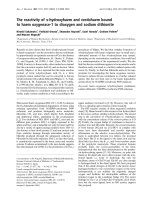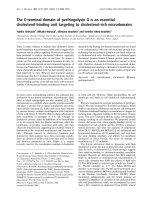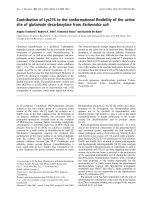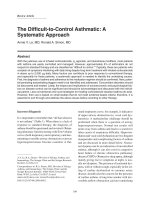Báo cáo y học: "The many routes to regulating mRNA translation" pot
Bạn đang xem bản rút gọn của tài liệu. Xem và tải ngay bản đầy đủ của tài liệu tại đây (93.79 KB, 4 trang )
Genome Biology 2006, 7:332
comment
reviews
reports
deposited research
interactions
information
refereed research
Meeting report
The many routes to regulating mRNA translation
Kristian E Baker and Jeff Coller
Address: Center for RNA Molecular Biology, Case Western Reserve University, School of Medicine, Cleveland, OH 44106, USA.
Correspondence: Jeff Coller. Email:
Published: 15 December 2006
Genome Biology 2006, 7:332 (doi:10.1186/gb-2006-7-12-332)
The electronic version of this article is the complete one and can be
found online at />© 2006 BioMed Central Ltd
A report on the meeting ‘Translational Control’ at Cold
Spring Harbor, New York, 6-10 September 2006.
Regulation of gene expression at the level of mRNA trans-
lation is a fundamental mechanism for moderating cellular
events. A recent meeting at Cold Spring Harbor Laboratory
served to highlight the modes, mechanisms, and architecture
of translational control and of the translational apparatus
itself (a full list of presentations is available at [http://
meetings.cshl.edu/meetings/abstracts/2006transc_absstat.
html]). This report concentrates on several prominent
themes in the regulation of mRNA translation. Central to the
topics discussed here is the observation that the translation
of single specific mRNAs, subsets, or even a majority of the
mRNAs in a cell, is controlled almost exclusively through a
multitude of interactions that occur between RNA-binding
proteins and regulatory elements embedded throughout the
mRNA (Figure 1).
A common architecture for translational
repression
Binding of proteins to regulatory elements in the 3Ј untrans-
lated region (3Ј UTR) of mRNA can facilitate repression of
mRNA translation, and evidence suggests that several
mRNAs that can be regulated in this way are controlled via a
common messenger ribonucleoprotein (mRNP) architec-
ture. The core repression complex consists of proteins that
mediate an interaction between the 3Ј UTR-binding proteins
and an mRNA 5Ј cap-binding protein, either the translation
initiation factor eIF4E or a mimic. This arrangement
sequesters the mRNA 5Ј cap in a nonproductive closed-loop
conformation and inhibits an obligatory step in translational
initiation. An example of this mode of control was presented
by Paul Lasko (McGill University, Montréal, Canada), who
described the repression of two mRNAs, hunchback and
caudal, that are important for axis formation in the
Drosophila embryo. An important point to note is that
although the recognition elements within the two mRNAs
bind distinct proteins, the respective mRNP complexes both
lead to repression of translation through an interaction with
a unique mRNA cap-binding protein, 4EHP.
Claudia Bagni (University of Rome, Italy) reported that the
specificity of translational repression of target mRNAs by
the fragile X mental retardation protein (FMRP) in neuron
dendrites is achieved not through accessory proteins but
through the noncoding RNA, BC1. BC1 acts as a bridging
molecule for FMRP, which in turn interacts with the novel
neuronal eIF4E-binding protein, Cyf1p. Binding of eIF4E by
Cyf1p is believed to underlie a cap-dependent mechanism of
translational repression that is important for properly
regulated protein synthesis at the synapse and for learning
and memory. While sequestration in cis of the mRNA 5Ј cap
has emerged as a fundamental mechanism for preventing
translation, it remains to be seen whether differences in
composition of the mRNPs are due simply to tissue
specificity or whether they provide additional complexity or
plasticity to the regulatory event.
MicroRNAs, translational repression, and
mRNP aggregates
MicroRNAs (miRNAs) have emerged in recent years as
mRNA-specific regulators of translation. Witold Filipowicz
(Friedrich Miescher Institute for Biomedical Research,
Basel, Switzerland) discussed evidence that repression of
mRNA translation by miRNA is reversible. He presented
data from human cell culture studies showing that miR122
represses translation of the arginine/lysine transporter
CAT-1 mRNA and enriches the localization of the target
mRNA in P bodies, which are cytoplasmic mRNP granules
believed to be sites of mRNA storage and/or mRNA
degradation. Under conditions of amino acid deprivation or
other stress, repression is relieved, and the mRNA re-enters
active translation, concomitant with the loss of target mRNA
co-localization with P bodies, an effect dependent on the
RNA-binding protein HuR. The observation that an mRNA
can cycle between repressed and translationally active states,
and that this cycling may involve a spatial segregation within
the cell cytoplasm, was supported by Roy Parker (University
of Arizona, Tucson, USA). His results from yeast studies
support the hypothesis that all cellular mRNAs cycle through
P bodies, and that this movement represents a fundamental
aspect of the mRNA life cycle that has been previously
unrecognized but which is important for regulation of
mRNA metabolism, including translational control.
The elucidation of a role for P bodies in the control of mRNA
translation by miRNA will benefit from new insight that may
result from studies presented by Rolf Thermann (EMBL,
Heidelberg, Germany). He described an in vitro experi-
mental system to evaluate miRNA-mediated translational
control using Drosophila embryo extracts, and presented
evidence that this translational repression resulted in a
dramatic reduction in the association of 48S translational
initiation complex with the mRNA, but an accumulation of
mRNP complexes with sedimentation coefficients greater
than 80S. These findings are consistent with the hypothesis
that the aggregation of mRNAs into large mRNP complexes,
which may correspond to P bodies or other cytoplasmic foci, is
an important mechanism in mRNA translational repression.
Polyadenylation and translational activation
The relative level of polyadenylation at the 3Ј end of the
message has great impact on the translational status of an
mRNA. During early embryonic development, the trans-
lation of specific maternal mRNAs is activated through the
addition, in the cytoplasm, of a poly(A) tail, and the
specificity of this polyadenylation has been ascribed to cis-
acting elements in the RNA. Eulalia Belloc (Centre de
Regulacio Genomica, Barcelona, Spain) described how
mRNA elements that mediate polyadenylation (cytoplasmic
polyadenylation elements) can be found alongside recog-
nition elements that lead to mRNA deadenylation (AU-rich
332.2 Genome Biology 2006, Volume 7, Issue 12, Article 332 Baker and Coller />Genome Biology 2006, 7:332
Figure 1
Regulation of eukaryotic mRNA translation occurs at numerous control points. Recognition of 3Ј UTR sequence or structural elements (green and red
boxes) by RNA-binding proteins leads to either activation or repression of translation, often through alteration of the 3Ј poly(A) tail or through
interactions with proteins that bind at the 5Ј terminal cap structure (that is, the initiation factor eIF4E or cap-binding proteins). Repression of translation
by miRNAs can occur through inhibition of translation initiation or elongation, and may also lead to changes in the status of the mRNA 3Ј poly(A) tail.
Elements found within the mRNA 5Ј UTR (yellow box) can bind regulatory proteins that repress translation by inhibiting 48S ribosome scanning. Global
regulation of mRNA translation is commonly achieved through modification of the translational apparatus (that is, by phosphorylation of the translation
initiation factors eIF2␣ and eIF4E) and the ribosome itself, or modulation of protein partner binding affinities (such as the phosphorylation of the eIF4E-
binding proteins). Translation can be initiated independent of the mRNA 5Ј cap through a structured internal ribosome entry site (IRES) in the 5Ј UTR
whose efficiency in initiating translation is, in turn, modulated by trans-acting factors (ITAFs).
AAA
(N)
3′ UTR
binding protein
miRNA or protein binding to
3′ UTR modulates translation
at several control points
Ribosome
eIF4E
IRES
eIF4E-
binding
proteins
Cap-binding
proteins
Inhibits
translation
Inhibits
translation
eIF2α
P
3′ UTR binding
elements
5′ cap
5′ UTR binding
element and
binding protein
eIF2α
P
P
P
microRNAs
P
P
ITAF binding modulates
IRES function
elements). The relative arrangement of these elements may
have an impact on the polyadenylation profile of the mRNA.
These findings suggest that combinatorial binding of
proteins to these elements mediates complex and potentially
reversible changes to the mRNA poly(A) tail and the
translation status of mRNA. Joel Richter (University of
Massachusetts Medical School, Worcester, USA) discussed a
means of temporal control of mRNA translation through
changes in poly(A) tail length by the restructuring of a
3Ј UTR mRNP. He suggested that, in response to
phosphorylation of the cytoplasmic polyadenylation element
binding protein (CPEB), poly(A) ribonuclease becomes
displaced from the multiprotein mRNP, thereby facilitating
poly(A) addition catalyzed by another complex member,
Gld-2, a noncanonical poly(A) polymerase.
Using polyadenylation state array (PASTA) analysis to
separate and identify mRNA populations from Saccharomyces
cerevisiae on the basis of poly(A) tail length, Thomas Preiss
(Victor Change Cardiac Research Institute, Sydney, Australia)
reported positive correlations between poly(A) tail length
and ribosome density (representing active translation), and
the possible co-regulation of functionally related mRNAs
through poly(A) tail status. Interestingly, an overall corre-
lation between poly(A) tail length and mRNA stability was
not observed; however, the association of poly(A)-binding
protein (PAB) with the mRNA was shown to correlate with
tail status. Supporting the popular theory that PAB
association with mRNA, rather than the poly(A) tail itself,
acts as the overall modulator of translation, Glover Martin
(Massachusetts Institute of Technology, Cambridge, USA)
described the efficient expression of a non-adenylated
mRNA from dengue virus through binding of PAB to the
mRNA 3Ј UTR despite absence of a poly (A) tail.
Cell signals and translational control of mRNA
subpopulations
Under certain cellular conditions, the regulation of large
numbers of different mRNAs may be necessary to respond to
stimuli or maintain homeostasis. David Stokoe (University
of California, San Francisco, USA) described the identifi-
cation of a class of cellular mRNA targets whose translation
is boosted by the mammalian target of rapamycin (mTORC1)
signaling pathway, an important regulator of cell growth that
acts by stimulating the initiation of translation. This analysis
capitalized on the observation that, in conditions of limiting
growth factors or nutrient withdrawal, protein synthesis
from this class of mRNAs is prevented through the inhibit-
ory action of two mTORC1 pathway members, tuberous
sclerosis complex (TSC) proteins 1 and 2. Mutant cells
defective in TSC function cannot prevent target mRNA
translation in such conditions, and Stokoe carried out a
microarray analysis comparing RNA isolated from polysome
and non-polysome fractions from wild-type and Tsc1- or
Tsc2-deficient mouse embryo fibroblasts in conditions of
serum withdrawal. The results show that translation from
mRNAs harboring a 5Ј-terminal oligopyrimidine (TOP) tract
within their 5Ј UTRs is normally dramatically up-regulated
in wild-type cells. Stokoe also showed that the 5Ј UTRs of
many of the regulated mRNAs were sufficient to confer
translational control on reporter genes in cis. The
observation that TOP-containing mRNAs encode
predominantly ribosomal proteins and components of the
translation machinery suggests that this mechanism of
mRNA class-specific modulation of translation in response
to environmental changes can control global protein
synthesis. Indeed, Oded Meyuhas (Hebrew University-
Hadassah Medical School, Jerusalem, Israel) discussed the
hypothesis that the unrestrained cell proliferation associated
with a deficiency in TSC1 or TSC2 in cultured mammalian
cells may result from the derepression of TOP mRNA
translation.
In regard to the role of miRNA in controlling translation, Ulf
Ørom (University of Copenhagen, Denmark) reported that
miR10a can interact with the 5Ј UTR of mRNAs harboring
the TOP regulatory motif and impact, both negatively and
positively, on their translation. As well as showing that a
miRNA may play a role in enhancing mRNA translation,
these findings also suggest that miRNAs might be able to
affect global protein production by regulating the levels of
the translational apparatus within the cell.
It is generally accepted that mRNA translation is down-
regulated at the onset of mitosis. Current hypotheses for the
underlying mechanism propose that it is the initiation of
translation that is inhibited. Gilad Sivan (Tel-Aviv Univer-
sity, Israel) reported, in contrast, that in cells whose cycle is
synchronized in the absence of drugs, the broad decrease in
mRNA expression at mitosis is associated with a persisting
association of mRNA with ribosomes. This indicates that
control of mRNA translation during mitosis can occur at
multiple points, including inhibition of ribosome elongation
or translation termination.
Control of global mRNA translation by
alterations in the translation apparatus
The translation of mRNA can be repressed globally in
response to cellular perturbations, either as a mechanism
for short-term adaptation or to ensure long-term survival.
One conserved mechanism involves phosphorylation of the
initiation factor eIF2␣, which inhibits ternary complex
formation and precludes translation of the majority of
mRNAs in the cell (that is, those requiring the 5Ј cap for
their expression and many harboring internal ribsome
entry sites (IRES)), and numerous protein kinases
specifically target eIF2␣ at differing cell stages or levels of
stress. Douglas Cavener (Pennsylvania State University,
University Park, USA) and Donalyn Scheuner (University
of Michigan, Ann Arbor, USA) both discussed the
comment
reviews
reports
deposited research
interactions
information
refereed research
Genome Biology 2006, Volume 7, Issue 12, Article 332 Baker and Coller 332.3
Genome Biology 2006, 7:332
importance of eIF2␣ phosphorylation by pancreatic
endoplasmic reticulum eIF2α kinase (PERK) in
maintaining insulin-secreting beta-cell function. Using a
series of tissue- and cell-specific Perk knockout mice,
Cavener presented data suggesting that defects in beta-cell
differentiation and proliferation during embryonic
development underlie the deficiency in glucose-stimulated
insulin secretion and proinsulin trafficking in postnatal
mice. In contrast, Scheuner presented data from mice
harboring homozygous mutations at the regulatory
phosphorylation site of eIF2
␣
, indicating that, in the absence
of eIF2␣ phosphorylation, beta-cells underwent apoptotic cell
death. It therefore remains under debate how regulation of
eIF2␣ by PERK prevents the symptoms of diabetes; however,
the need to regulate global protein synthesis to prevent
manifestations of human disease is certain. A role for eIF2␣
phosphorylation in behavioral learning was described by
Mauro Costa-Mattioli (McGill University, Montreal, Canada)
in experiments with mice in which the phosphorylation status
of eIF2␣ was modulated. Mutations that decrease eIF2␣
phosphorylation led to enhanced long-term memory,
whereas treatment with a drug that prevents eIF2␣ dephos-
phorylation impaired long-term memory. Together, these
studies highlight eIF2␣ and global translational control as
key effectors of cellular function.
A wide range of cellular stresses lead to the dampening of
overall protein synthesis through the functional activation,
by dephosphorylation, of the inhibitory eIF4E-binding
protein 4E-BP1. In contrast, modification of eIF4E once it is
incorporated into the eIF4F translational initiation complex
leads to both positive and negative effects on cap-dependent
mRNA translation. Carolina Arias (New York University
School of Medicine, New York, USA) unveiled a biological
role for the ‘nonessential’ phosphorylation of eIF4E
catalyzed by the protein kinases Mnk1 and Mnk2, which are
activated by the mitogen-activated protein kinase (MAPK)
pathway. When stressed by infection with vaccinia virus,
mouse cells deficient in Mnk1 displayed reduced eIF4E
phosphorylation and impairment of virus replication and
protein synthesis, despite the presence of Mnk2.
An emerging but poorly understood control point for the
regulation of mRNA translation is through modification of
the ribosome itself. Chemical modifications of ribosomal
proteins or rRNA, or changes in the association of ribosomal
or nonribosomal proteins, are postulated to lead to
adjustments in the affinity of the ribosome for particular
classes of mRNAs. Vivian MacKay (University of
Washington, Seattle, USA) discussed a genetic screen in
Saccharomyces cerevisiae that revealed a relationship
between the protein composition of the 60S ribosomal
subunit and aging. Deletion of any of several genes encoding
proteins of the large ribosomal subunit led to a significantly
longer life span, and deletion of various genes involved in
60S processing or maturation also resulted in longer lived
cells. Further research will be needed to understand this
intriguing observation.
To evaluate whether ribosome modifications have a role in
adjusting translation, Camille Diges (Stanford University
School of Medicine, Palo Alto, USA) presented mass
spectrophotometric analysis of ribosomes purified from
uninfected and poliovirus-infected HeLa cells. Global
changes to the posttranslational modifications of the
ribosomal proteins were observed, including an overall gain
in ribosomal subunit di-methylation and either a decrease or
alteration in protein acetylation in 40S and 60S subunits,
respectively, upon viral infection. On the basis of these
preliminary observations, Diges proposes that post-
translational modification of the ribosome fine tunes the
binding of non-ribosomal proteins and, in turn, modulates
the affinity of the ribosome for specific mRNAs, thereby
enabling the ribosome to act directly as a regulator of
translation. It remains unclear, however, if the observed
changes in ribosome modifications described by Diges do
indeed lead to increased efficiency of viral RNA translation;
further experiments will be needed to validate this exciting
and novel form of translational control.
Further elucidation of the molecular events underlying the
regulation of mRNA translation, the discovery of new
mechanisms, and the identification of the mRNA targets at
each control point, will serve to complement our already
broad understanding of translational control within the cell.
It is already clear that careful balancing of protein synthesis
is essential for critical processes such as embryonic
development and cellular adaptation, and learning and
memory.
332.4 Genome Biology 2006, Volume 7, Issue 12, Article 332 Baker and Coller />Genome Biology 2006, 7:332









